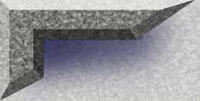|
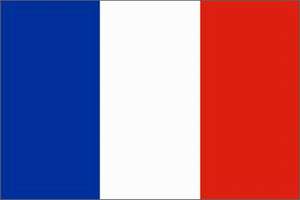
Since
the first day of hostilities, France's war ministry began a staggering juggling act: Feeding their own troops, the troops
of her allies, and all of France's colonial troops, relying only on a network of foreign suppliers, limited local production,
and sketchy at best colonial tithes arriving in smaller supply than the hungry troops dispatched to the conflict from the
colonies.
Initially,
Frances armed forces were designed to fight, fend for, and feed at a company or battalion level. This meant that soldiers
who were line infantrymen might also be cooks, laborers, supply clerks and maintenance personnel, with fatigue details being
assigned on a rotational basis between the non-specialists. In garrison, or on maneuvers, this worked splendidly. When the
day's work was done, the cooking detail would set up the kitchen area, cook and serve the meal, and everyone was happy.
For
emergency use, troops carried an emergency ration, but no one would touch that except in old Legionnaires' barroom tales of
the Legion in 'wild places'.
Add
to this mix about 2.8 million German troops (700,000 regulars and 2.1 million activated reserves) with the expressed purpose
of having lunch in gay Paris...
...and
suddenly, company level kitchens were impossible to run in the field, especially in hotly contested locations, where doing
anything but remaining behind cover meant certain death.
At
the same time, the peacetime provisions which, if not opulent, were superb to most in Europe, suddenly had to be divided 5
ways, with Frances forces expanding from 823,000 peacetime troops to a whopping 3,723,000 at the onset of war. This was not
counting British expeditionary forces, colonial troops, remnants of the Belgian army and foreign volunteers.
While
the front lines were still somewhat flexible, field unit based kitchens were becoming less and less feasible. By the time
the front froze at the trench line from the channel to the Swiss border, they had become impossible. Many troops would receive
fresh ration supplies, but with the trench networks initially only being laid out for close-up combat, no provisions for regular
cooking was made.
This
meant that troops subsisted on fresh bread, fruit, wine and sausages. Iron rations were limited due to supply shortages, and
generally the only warm meal happened if a section or a platoon managed to set up a makeshift kitchen to use the supplies
arriving in an irregular fashion before they could spoil. Even then, the best troops could hope for was some sort of soup
or stew, or a cup of coffee if they were not so lucky.
No
standard caloric intake requirement was set, and no semblance of a functional supply system existed until early 1915, when
French planners in the Ministry of War finally had a modicum of breathing room to allow for action besides the constant filling
of gaps, reacting to German advances and trying to coax more allies to help out with the war effort. This also allowed for
the new concept of field kitchens, preparing meals behind the lines, which in theory then would be delivered/picked up and
brought to the trenches in large food transport tins with carrying frames similar to backpacks.
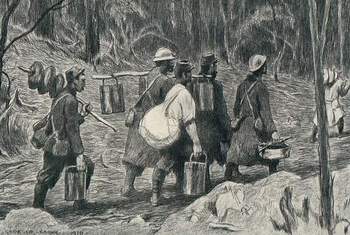
By
1915, 3 types of rations existed for the French soldier (messing separately from his vastly better fed and better supplied
officers).
1. The
Standard ration, consisting of a 14-day plan with meats, vegetables, desserts, breads and
other baked goods as well as wine.
This was the garrison ration, and generally was quite acceptable, as major messing facilities were set up near supply railheads
and other rear-echelon facilities, such as medical posts, rest camps and training facilities. Due to the prolonged tours of
duty in the trenches, combat troops got to see preciously little of these facilities, but would be surprised with an occasional
rotation to reduce combat fatigue.
2. The
Field ration consisting of an abbreviated menu and was the main ration type scheduled for troops. Traveling
kitchens would set up in areas adjacent to the combat zone, and would prepare more-or-less edible and definitely not nutritionally
balanced meals, which would then be hauled to the front lines. This detail of being a 'soup man' was considered to be a job
more hazardous than combat infantryman, as you had to traverse ground generally covered by enemy pre-planned artillery fires,
while carrying equipment that made it hard to seek cover, run or hide.
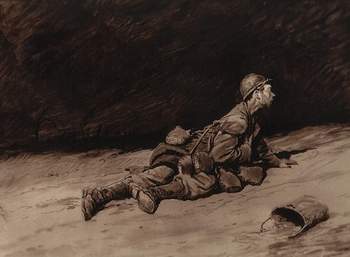
Food that did make it to the front was generally at least cold and of dubious quality, and often times
soiled and near inedible, such as bread that was carried without wrappers of any kind, coffee (le jus) transported in open
cans etc. Menus consisted of a variety of poorly prepared dishes, which include open
rack roasted meats, previously salted (and mostly too salty) fish, various pâtés made of meat scraps, lard and vegetables, rice, and beans of every description, at times
just cooked together in more or less edible stews. Luckily, along with these rations came (if at all possible) a serving of
'pinard', the cheap wine issued to all French forces. British troops lucky enough to get some eventually combined all French
terms like pinard or vin blanc into the ubiquitous (and still current!) term 'plonk', describing any cheap wine.
3. The
Reserve Food. This ration was the standard carried by French and colonial military personnel from 1915 onward,
and it must be said that although it was at times of atrocious quality, there was virtually never a shortage of its components,
which, due to their preserved nature did reach the troops in unspoiled, if not always appetizing condition. In stark contrast
to this, British troops, for example, often went without their equivalent Iron rations due to even worse supply mishaps and
mismanagement.
Click here to see a list of the « vivres de réserve » ration components, along
with some pictures of French kit.
Of
course, as in all armies at any given time and any given war, the French soldiers were able to draw from several other legal
(and quite a few illegal) supply sources.
First,
of course, there were rations mailed to troops from home, either from friends or families, or from beneficial groups and organizations,
industrials, schools and fund drives.
These
generally were frequent, at least in the in the case of family supplied packages, as France, in contrast to Germany had allocated
equal rations to civilians and soldiers, and thus the home front could share.
And
even though official packages were less frequent, they tended to have rare treats, such as real coffee, chocolates, and liquor,
better grades of tinned meats and fish, and tobacco.
Secondly,
troops would purchase food (so-called 'suppléments personnels') at every opportunity against the possibility of the supply
channels breaking down as they often did.
These
purchases were made in rear areas during hospital stays, leaves, delousing breaks and in occupied towns not directly in action.
Rear echelon areas were also the market place for reduced-cost additional rations items, such as preserved meats, the occasional
pack of tobacco, sweets, cakes and fresh bread.
Thirdly,
troops, as soldiers in all armies at all times, 'organized/liberated' supplies.
Generally
items would be procured off the back of supply trucks, liquor would be traded for food etc.
Notably,
the French army had extremely few cases of theft from civilians. For one, French soldiers were fighting on their own soil,
trying to protect civilians from the Germans plundering and the population was sharing all they could with the troops already.
Of
course, draconian discipline and courts-martials that punished everything seen as a subversive/moral-decaying act with a trip
to the firing squad ensured that those few who dared could be used as examples...
The title
of this Page Ratatouille Froid makes reference to the Niçoise dish Ratatouille, a vegetable soup/stew often on the
French Armys Field Ration plan as La Soupe.
But, of course, it never came
closer than stewed unseasoned vegetables in thin broth, bulked up with what Henri
Barbusse described in his classic 1916 essay Le feu as suspicious potatoes If you are ready to try Ratatouille proper, click here for a recipe
Foreign
troops (especially British units and colored U.S. units under French command, such as the Harlem Hell Fighters of
the valorous and highly decorated 369th Infantry Regiment of the New York National Guard's 15 Regiment) were initially not
pleased with French rations.
Later,
however, many British soldiers would describe the French food as queer but plentiful, while many US troops (Yanks of any color
being a bit more adventurous than Europeans) would actually develop a true taste for French foods and beverages.
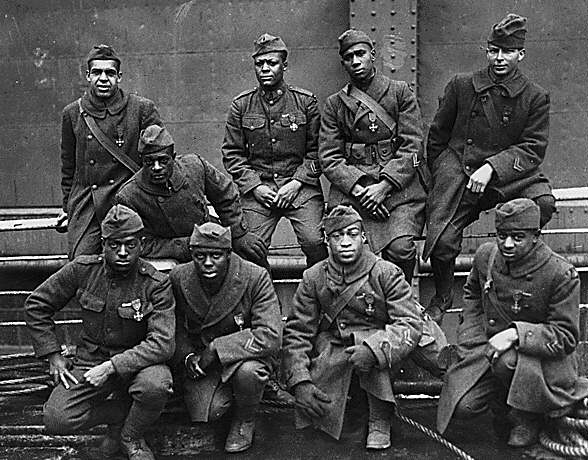
Much
of this influence can still be seen today in menus at various New York diners either opened or purchased after the war by
returning black and white troops alike, and which to this day feature menus influenced not by French 'fine dining', but rather
robust canteen dining, ranging from soups resembling Ratatouille over real French bread recipes to non-trendy French coffees
like café lait or chicory coffee.
|
